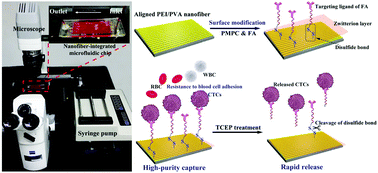当前位置:
X-MOL 学术
›
Mater. Chem. Front.
›
论文详情
Our official English website, www.x-mol.net, welcomes your
feedback! (Note: you will need to create a separate account there.)
Integration of aligned polymer nanofibers within a microfluidic chip for efficient capture and rapid release of circulating tumor cells†
Materials Chemistry Frontiers ( IF 6.0 ) Pub Date : 2018-01-15 00:00:00 , DOI: 10.1039/c7qm00570a Yunchao Xiao 1, 2, 3, 4, 5 , Mengyuan Wang 1, 2, 3, 4, 5 , Lizhou Lin 6, 7, 8, 9, 10 , Lianfang Du 6, 7, 8, 9, 10 , Mingwu Shen 1, 2, 3, 4, 5 , Xiangyang Shi 1, 2, 3, 4, 5
Materials Chemistry Frontiers ( IF 6.0 ) Pub Date : 2018-01-15 00:00:00 , DOI: 10.1039/c7qm00570a Yunchao Xiao 1, 2, 3, 4, 5 , Mengyuan Wang 1, 2, 3, 4, 5 , Lizhou Lin 6, 7, 8, 9, 10 , Lianfang Du 6, 7, 8, 9, 10 , Mingwu Shen 1, 2, 3, 4, 5 , Xiangyang Shi 1, 2, 3, 4, 5
Affiliation

|
Capture and detection of circulating tumor cells (CTCs) is of great significance in the early diagnosis, prognosis evaluation and personalized therapy of cancer. Herein, we report a unique microfluidic platform integrated with zwitterion-modified aligned polyethyleneimine/polyvinyl alcohol nanofibers for efficient capture and rapid release of CTCs. We show that zwitterions of poly(2-methacryloyloxyethyl phosphorylcholine) (PMPC) can be immobilized onto the aligned nanofibers via an atomic transfer radical polymerization approach. The combined strategy of using aligned nanofibers instead of random nanofibers and PMPC immobilization endows the nanofibers with excellent antifouling properties against protein adsorption and blood cell attachment, thereby significantly improving the capture purity of cancer cells. Meanwhile, the targeting ligand folic acid (FA) can be modified onto the surface of nanofibers via a redox-sensitive disulfide bond to specifically and efficiently capture cancer cells overexpressing FA receptors and to rapidly release the cancer cells in a non-destructive manner through tris(2-carboxyethyl)phosphine treatment. The dynamic capture assay using the fiber-integrated microfluidic platform demonstrates that FA receptor-expressing cancer cells can be isolated with a high capture efficiency (92.7%) and considerable purity (43.4%) in a time period of 30 min and can be rapidly detached from the nanofibrous substrates within 5 min with a release efficiency up to 98.9%. These results as well as the isolation and detection of CTCs from the blood of cancer patients suggest that the developed microfluidic chip may be potentially used for clinical cancer diagnosis applications.
中文翻译:

将对齐的聚合物纳米纤维整合到微流控芯片中,可有效捕获并快速释放循环中的肿瘤细胞†
循环肿瘤细胞(CTC)的捕获和检测在癌症的早期诊断,预后评估和个性化治疗中具有重要意义。在这里,我们报告了一个独特的微流控平台,该平台与两性离子改性的对齐的聚乙烯亚胺/聚乙烯醇纳米纤维集成在一起,可有效捕获和快速释放四氯化碳。我们表明,聚(2-甲基丙烯酰氧基乙基磷酰胆碱)(PMPC)的两性离子可以通过以下方式固定在对齐的纳米纤维上原子转移自由基聚合方法。使用对齐的纳米纤维代替无规纳米纤维和PMPC固定化的组合策略使纳米纤维具有出色的防污性能,可防止蛋白质吸附和血细胞附着,从而显着提高了癌细胞的捕获纯度。同时,所述靶向配体的叶酸(FA)可以被修改到纳米纤维的表面通过氧化还原敏感的二硫键可特异性和有效地捕获过表达FA受体的癌细胞,并通过三(2-羧乙基)膦处理以非破坏性方式快速释放癌细胞。使用纤维集成的微流体平台进行的动态捕获分析表明,表达FA受体的癌细胞可以在30分钟的时间内以高捕获效率(92.7%)和相当高的纯度(43.4%)进行分离,并且可以快速分离5分钟内从纳米纤维基质中分离出来,释放效率高达98.9%。这些结果以及从癌症患者血液中分离和检测CTC的结果表明,开发的微流控芯片可能潜在地用于临床癌症诊断应用。
更新日期:2018-01-15
中文翻译:

将对齐的聚合物纳米纤维整合到微流控芯片中,可有效捕获并快速释放循环中的肿瘤细胞†
循环肿瘤细胞(CTC)的捕获和检测在癌症的早期诊断,预后评估和个性化治疗中具有重要意义。在这里,我们报告了一个独特的微流控平台,该平台与两性离子改性的对齐的聚乙烯亚胺/聚乙烯醇纳米纤维集成在一起,可有效捕获和快速释放四氯化碳。我们表明,聚(2-甲基丙烯酰氧基乙基磷酰胆碱)(PMPC)的两性离子可以通过以下方式固定在对齐的纳米纤维上原子转移自由基聚合方法。使用对齐的纳米纤维代替无规纳米纤维和PMPC固定化的组合策略使纳米纤维具有出色的防污性能,可防止蛋白质吸附和血细胞附着,从而显着提高了癌细胞的捕获纯度。同时,所述靶向配体的叶酸(FA)可以被修改到纳米纤维的表面通过氧化还原敏感的二硫键可特异性和有效地捕获过表达FA受体的癌细胞,并通过三(2-羧乙基)膦处理以非破坏性方式快速释放癌细胞。使用纤维集成的微流体平台进行的动态捕获分析表明,表达FA受体的癌细胞可以在30分钟的时间内以高捕获效率(92.7%)和相当高的纯度(43.4%)进行分离,并且可以快速分离5分钟内从纳米纤维基质中分离出来,释放效率高达98.9%。这些结果以及从癌症患者血液中分离和检测CTC的结果表明,开发的微流控芯片可能潜在地用于临床癌症诊断应用。











































 京公网安备 11010802027423号
京公网安备 11010802027423号